We cast our nets wide this week to catch the science of aquaculture or fish farming! We'll find out how farming marine life can reduce reliance on disappearing wild stocks, and explore the effect on the local environment. Also, how recycled fish poo and waste water can help repair damaged wetlands, and in Naked Engineering we find out how robotic fish can keep tabs on pollution in ports.
In this episode
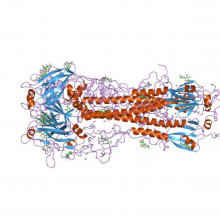
01:25 - Bespoke Proteins Bind ‘Flu
Bespoke Proteins Bind ‘Flu
Researchers in Seattle and Washington have solved an "enormous jigsaw puzzle" to design two novel proteins that bind to a protein found in influenza viruses, proving that computer designed proteins are feasible and could form the basis of new drugs and biosensors. They report on the work in the journal Science this week.
Protein-protein interactions are a common biochemical process, important in a great many biological systems, and are controlled by their molecular structure. For two proteins to bind, they need complimentary shapes that can fit together like a lock and key, with no overlap and little empty space.
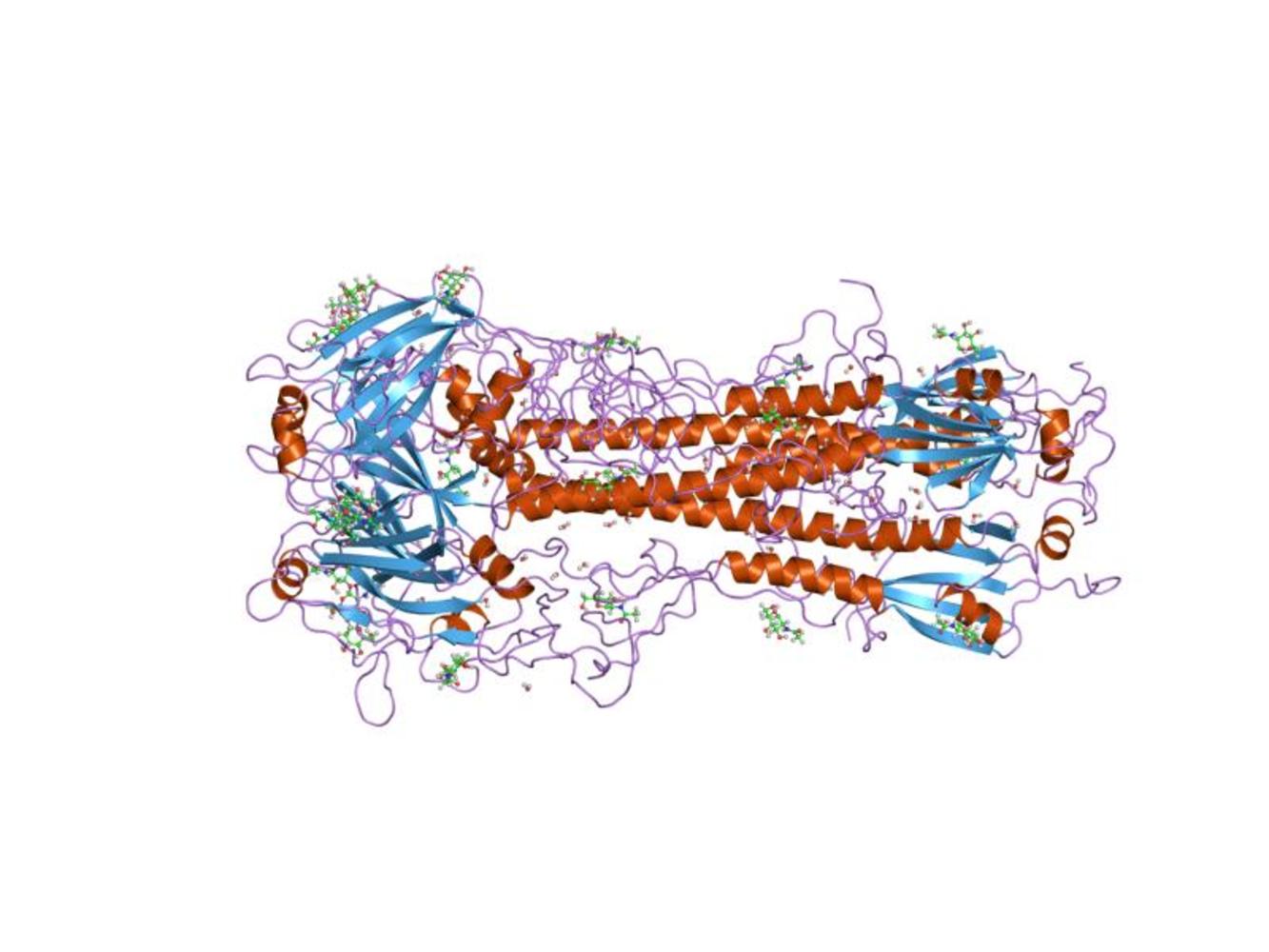 Sarel J. Fleishman at the University of Washington, along with colleagues in California, used cutting edge software and over 100,000 hours of parallel computing time to design new proteins that would bind to the tail of a common virus protein, Hemagglutinin, from the 1918 H1N1 'flu strain. This protein helps the virus to invade cells, and is found in many strains of influenza. Most natural antibodies bind to the variable head of the protein, leaving room for the virus to evolve immunity, but the tail is highly conserved across strains, making it an excellent target for attack.
Sarel J. Fleishman at the University of Washington, along with colleagues in California, used cutting edge software and over 100,000 hours of parallel computing time to design new proteins that would bind to the tail of a common virus protein, Hemagglutinin, from the 1918 H1N1 'flu strain. This protein helps the virus to invade cells, and is found in many strains of influenza. Most natural antibodies bind to the variable head of the protein, leaving room for the virus to evolve immunity, but the tail is highly conserved across strains, making it an excellent target for attack.
To design the protein, they first identified hot-spots of interaction on the virus protein. These are areas where hydrogen bonding and electrostatic interactions allow for low-energy bonding of complimentary structures. With a map of these hot-spots, they set about putting the jigsaw pieces together and designing a structure that would compliment, and therefore bind to, the protein.
Candidate proteins were tested using a highly efficient yeast-based assay, and two of the designed proteins, HB36 and HB80, were shown to bind well with the 1918 H1N1, as well as others strains of H1N1 and H5N1. One of the proteins, HB80, also inhibits protein changes important in infection.
Although by no means perfect, and there will be many hurdles to cross before designed proteins become useful medications, this is an excellent example of successful computer-aided-protein design, a technique that could be instrumental in future diagnostics and treatment.
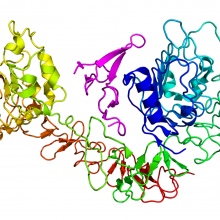
07:28 - Lasers Identify Key Molecular Structure in Tumours
Lasers Identify Key Molecular Structure in Tumours
with Dr Marisa Martin-Fernandez; STFC’s Central Laser Facility & Dr Martyn Winn; Computational Science and Engineering Department
Ben - Also in the news this week, a laser technique has exposed the previously unknown molecular shape of Epidermal Growth Factor Receptors or EGFRs which are known to be involved in the development of cancer. These are found on the surface of the vast majority of human cells as Dr. Marisa Martin-Fernandez, a scientist based at the STFC's Central Laser Facility in Harwell explained...
Marisa - The role of this receptor is to bind molecules which are in the bloodstream and produce signals which are transduced to the inside of each cell and to give instructions to the cell machinery to grow, divide, die, differentiate. So it's kind of the core of how to promote cell behaviour. These are the orchestrators, these type of receptors orchestrate what cells are going to do within a multicellular body and there is a lot that is known about what happens in this signalling process that leads to cellular growth and when it goes wrong and leads to the growth of tumours. In fact, most human tumours have a fault in the signalling of this receptor.
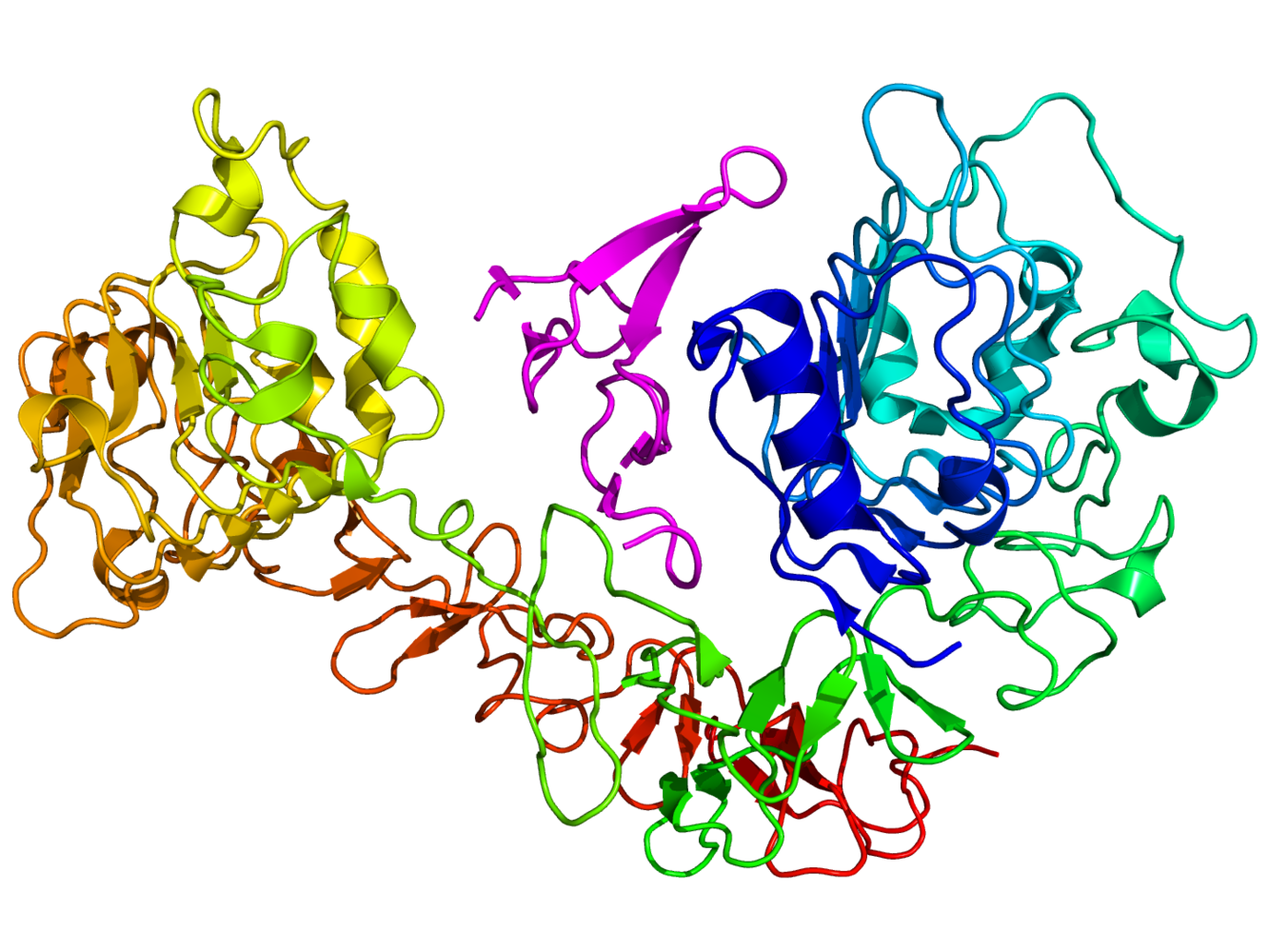 Ben - Current drugs that target EGFRs do so non-discriminately, blocking activation to halt cell growth. However, in doing so, they may block other essential cell maintenance and this could lead to the body adopting other chemical pathways to achieve the same goal. This side steps the cancer treatment and allows the tumour to grow once more. To find out more about the precise interactions between EGFRs and signalling molecules, we need a good understanding of their structure. To do this, Marisa's team using novel laser technique called fluorescence resonance energy transfer...
Ben - Current drugs that target EGFRs do so non-discriminately, blocking activation to halt cell growth. However, in doing so, they may block other essential cell maintenance and this could lead to the body adopting other chemical pathways to achieve the same goal. This side steps the cancer treatment and allows the tumour to grow once more. To find out more about the precise interactions between EGFRs and signalling molecules, we need a good understanding of their structure. To do this, Marisa's team using novel laser technique called fluorescence resonance energy transfer...
Marisa - So what we do is we put a label in a position in the receptor that we can control, which is a molecule that emits fluorescence, and we put another label on the cell surface, and then we excite one of the molecules in the receptor. Depending on how close it is to the surface, the characteristics of the fluorescence emission are different and from that information, we can actually get nanometer distances.
Ben - Knowing the distances between the receptor and the other parts of the cell can help to simulate exactly what structure the receptor will take in situ. This job is taken on by experts such as Dr. Martyn Winn of the STFC's Computational Science and Engineering Department at the Daresbury laboratory...
Martyn - Our starting points are atomic structures that you get from crystallography. These are experiments that would take place on Diamond Light Source, for example, and they give you very detailed atomic structures of the proteins that are involved. The drawback of that is they're static. They don't move around like they do in real life. Also, that means that the proteins have been taken out of the cell, taken out of their natural context and put into a crystal. So you have very detailed information but it's not necessarily relevant to what's happening in the cell. So what we would do in a simulation is to take that detailed structure, set up a simulation which mimics the cell environment and then see what happens when it's put into the cellular context.
Ben - When Marisa's laser data was combined in a simulation with the known atomic structure of EGFRs, the resulting shape was new, unexpected, but surprisingly similar to a structure found in Drosophila, the fruit fly.
Martyn - So what you often see from crystallography is very symmetric structures. The crystal environment is a very symmetric environment and everything is nice and well ordered. What we saw when we did our simulation was that the molecule actually becomes asymmetric. When we first did this, this was something that had not been seen before and slightly heretic. People love symmetry. Symmetry is beautiful, but our simulations were showing that the molecule became asymmetric in order to explain Marisa's experiments.
Marisa - And then the amazing thing is that when we look at the molecular shape, it looked nearly identical to the molecular shape of the Drosophila receptor. And then when we identified the shape, it was virtually identical. It was so similar, it was actually uncanny. We were amazed, when we looked at the structure that we identified, and it looked like the Drosophila receptor, we knew we were onto something.
Ben - So, knowing this particular structure could help lead to better therapeutics and the technique itself could help move forward into personalised medicine.
Marisa - Given this new information, we could actually consider new antibody therapeutics that could block one of the other version of the receptor and allow the other signals to be transduced. So, in a way, they will be less invasive therapeutics that might actually reduce side effects, and make sure that, for example, the body is not deprived of a fundamental function that this receptor covers.
Martyn - And I think we're at the level of very basic science and it's a long road towards drug development, that's true, but I think one of the things that they want to do is to develop treatments that are specific to patients. So you can analyse the DNA from particular patients to see if they have particular mutations. It might be that you can also analyse the tumours of patients to see what the confirmation of the receptors are and then that might shed light on whether a particular antibody treatment is likely to work or not. That their interest, actually in implying this to patient-specific treatments.
Ben - That was Martyn Winn from the Daresbury Lab and Marisa Martin-Fernandez from the Central Laser Facility in Harwell. You can find that paper in the journal Molecular and Cellular Biology.
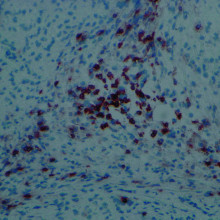
13:54 - Immune Roadblock to Stem Cell Treatment
Immune Roadblock to Stem Cell Treatment
Stem cells may be rejected by the animals they first came from, according to research published in the journal Nature this week. This could be a huge stumbling block in the use of induced stem cells for therapy.
Induced Pluripotent stem cells, or iPSCs, are created by taking normal cells from an animal, then exposing them to factors that could allow them to differentiate into any of the body's cells, much like embryonic stem cells. As they are genetically identical to the animal, it's been assumed that they would not cause an immune response, and therefore avoid rejection.
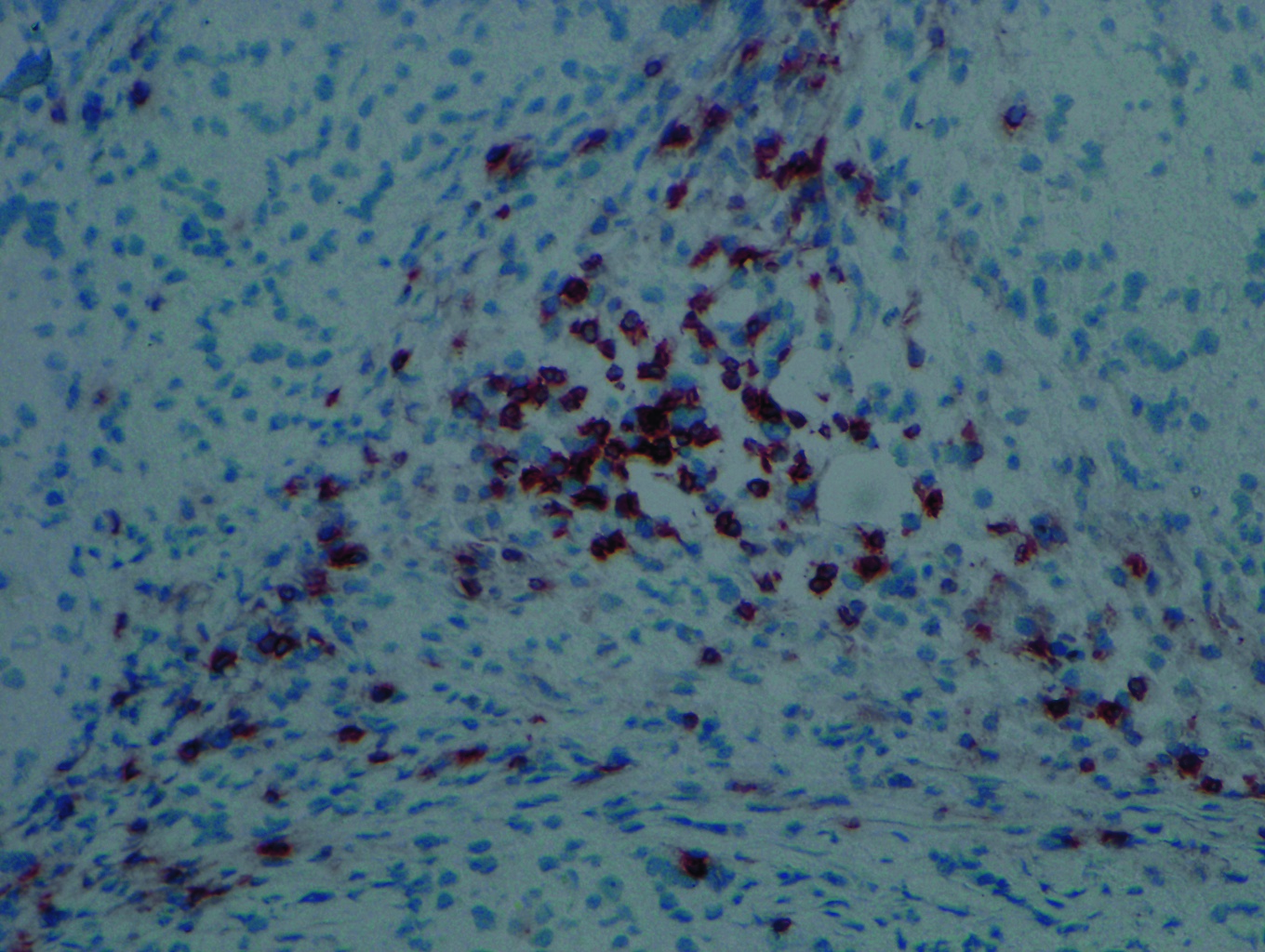 Now, Tongbiao Zhao and colleagues at the University of California, San Diego, have tested that assumption, and found that, at least for 2 of the methods of inducing pluripotency, it doesn't hold true.
Now, Tongbiao Zhao and colleagues at the University of California, San Diego, have tested that assumption, and found that, at least for 2 of the methods of inducing pluripotency, it doesn't hold true.
The team took mouse fibroblasts, cells that make up the structural component of skin, and used two different techniques to turn them into iPSCs before transplanting them into genetically identical mice. They did the same with embryonic stem cells for comparison.
The results were startling. The embryonic stem cells were mostly able to grow and divide within the mice, but the induced stem cells triggered an immune attack, growing to far smaller sizes and showing damage typical of immune rejection. Induced cells transplanted into immune deficient mice were able to grow and divide as normal.
Genetic comparisons showed certain genes were over expressed in the induced compared to embryonic stem cells, and subsequent testing showed that this is most likely to be responsible for inducing a T-cell mediated immune response.
This is a stumbling block for induced stem cell therapies, and shows that we need to ensure that cells created in this way are not just genetically identical to embryonic stem cells, but that we also need to account for epigenetic factors such as gene expression.
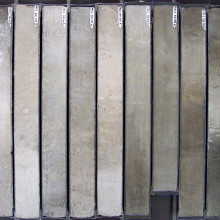
16:58 - Planet Earth Online - Sediment Cores Tell History of the Thames
Planet Earth Online - Sediment Cores Tell History of the Thames
with Chris Vane, British Geological Survey
Helen - Wading into a river and digging until you get to the slime, soil, dirt, and other matter at the bottom may not be everyone's idea of a great day out, but in the right hands, a core of river sediment can become an eye-opening time machine into the past. Planet Earth podcast presenter Richard Hollingham went to Nottingham to meet Senior Geochemist Chris Vane from the British Geological Survey. There, at its environment handling facility, Chris delved into a large freezer to reveal the secrets of river sediment cores...
Chris - We keep the cores frozen so that they preserve really well.
Richard - So let's open this up. It says "Thames Pollution" on the lid of a big chest freezer...
Chris - That's right. And you can see there's over 57 sediment cores in here, each of about 1 metre in length and then they're sealed at both ends.
Richard - Can I pick one up?
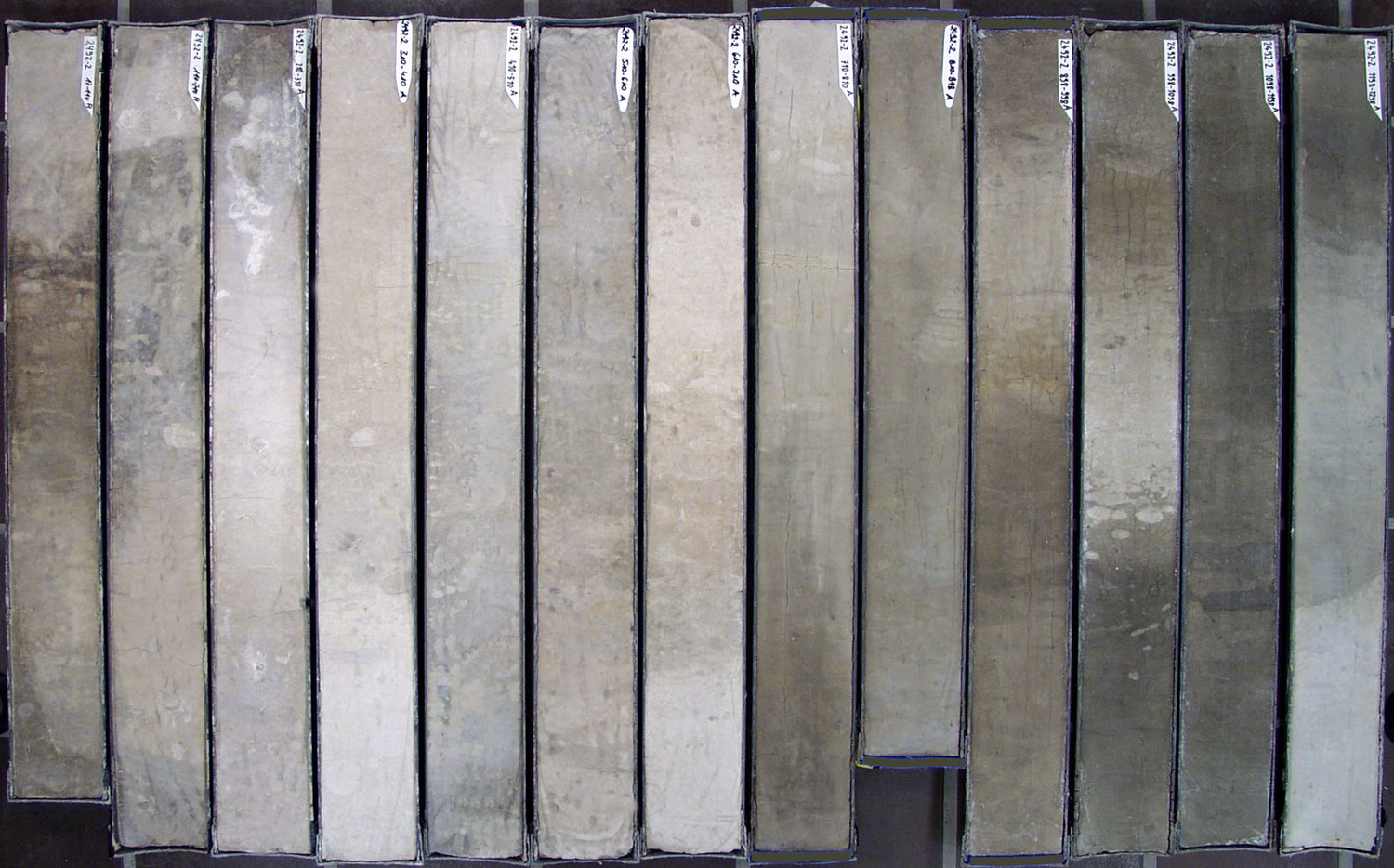 Chris - Absolutely, yeah.
Chris - Absolutely, yeah.
Richard - So you stood on the banks of the Thames and drilled this sediment out.
Chris - Yes. We simply used a hand coring device and pushed through the sediment.
Richard - So it's a metre long. How far back does it go?
Chris - We're probably going back here, to before the start of the industrial revolution, so around about 1750 let's say, would be the base of this core, and then even before the industrial revolution, there'll be a large number of chemical fossils associated with agriculture and things like that.
Richard - A record of humanity on the Thames.
Chris - A record of humanity on the Thames and how society and urbanisation of London has changed through time.
Richard - I'll let you put that down because it's very cold.
Chris - Yes.
Richard - And let's go back to the lab and see what you do with this data...
...And this is the organic geochemistry laboratory which is a white lab, full of white boxes and these are the analytical equipment with tubes and dials, and buttons. There's even what looks like an oven over there, why an oven?
Chris - It's very important for us to know the weight of the dry sediment, so it's useful to simply have a drying oven just to drive off the water so we have a standard weight of sample before we put it into this sophisticated instrumentation.
Richard - And from this, you can tell what chemicals are in those tubes of sediment?
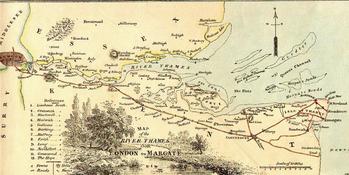 Chris - That's right. Go down those sediment tubes and take slices of that sediment, and then what we do is we analyse that on this instrumentation. And from that, we can look at different chemical relics of the past. For example, we can look at chemicals from major use of coals called PAHs, we can look at chemicals from hydraulic systems in industrialisation called PCBs, polychlorinated biophenols.
Chris - That's right. Go down those sediment tubes and take slices of that sediment, and then what we do is we analyse that on this instrumentation. And from that, we can look at different chemical relics of the past. For example, we can look at chemicals from major use of coals called PAHs, we can look at chemicals from hydraulic systems in industrialisation called PCBs, polychlorinated biophenols.
Richard - Small eras really. Eras of humanity and that human's influence on the environment.
Chris - That's right. What we're talking about here is basically dating something called the Anthropocene. It's this notion of basically, the current period we're living in, in which man has altered it, and then that alteration is preserved in the sediment.
Richard - And I suppose within that you've got the industrial revolution, you've got coal, you've got more recently, nuclear - you can see those?
Chris - That's right. We've got the coal age with elevated PAHs, we've got the fuel age, major use of vehicles, and we can tell that from total petroleum hydrocarbons and lead isotopes. Then we've got markers of the nuclear age through radionuclides and then these markers of the electrical age through PCBs, and other compounds such as flame retardants. Many of these compounds are resistant to biodegradation and so they're preserved in the sediment record.
Richard - This idea of the Anthropocene is interesting in itself, but can you use this information about pollution within these sediments? Is it relevant to the future?
Chris - Yes, it's very relevant to helping us manage our estuaries and rivers better because although many of the pollutants are preserved maybe a metre or so down in depth, these river and estuarine systems are liable to change as sedimentation changes, and they can actually be remobilized and move to the surface where they can impact both upon the ecology of the estuary and river but also upon humans. So although it seems like it's something which may have been deposited maybe in the 1930s, it's still relevant to us now because it can still impact us.
Richard - So you look at highly toxic chemicals like PCBs which were around in what, the 1950s and the 1960s.
Chris - Yes, '50s, '60s, '70s.
Richard - They're locked in the sediment at the moment but disturb that and they're released again into the environment.
Chris - Absolutely, so we need to understand basically where they are, where they are in time, and also the process via which they could be remobilized and affect humans.
Helen - Chris Vane, talking to Richard Hollingham about the fascinating insights gained from sediment cores from the river Thames.
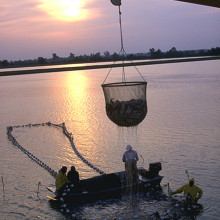
22:03 - The Pros and Cons of Aquaculture
The Pros and Cons of Aquaculture
with Dr Kenny Black, Scottish Association for Marine Science
If you've been shopping for a fish supper lately, then you've almost certainly been offered both farmed and wild fish. Fish farms are found all over the world and can be really a good way of reducing reliance on wild stock. But there are also some very real environmental concerns. To find out more about aquaculture in all of its forms, Ben Valsler spoke with Dr. Kenny Black, from the Scottish Association for Marine Science, to find out what fish farming involves...
Kenny - Fish farming is a kind of "catch all" as you say for aquaculture which is essentially the culture of any species, plant, animal, invertebrate, vertebrates in an aquatic environment. Essentially, in the sea, we've got everything from seaweeds, a whole variety of species that are cultured are seaweeds, used for a whole range of purposes. Through invertebrates, things like sea urchins, mussels, bivalves, up to the higher trophic level of carnivorous fish.
Ben - So it really is a broad range of things that we're farming here and it doesn't all have to be at sea, it doesn't all have to be in real rivers. Quite a lot of it is also happening on land in huge tanks.
Kenny - Yeah. There's a lot of tanks. Not so much tank stuff if you look at it in the very big picture. I mean, a lot of the actual big numbers as from which things are dominated by the far east. China particularly has a 2,000 year history - at least that long - of culturing carps in ponds, and that's still probably the biggest single aquaculture animal species cultured. There's a variety of different carp species in China.
Ben - So, how does this compare to wild fisheries? Thinking particular of food, how much of our fish food is supplied by aquaculture rather than just wild catching?
Kenny - Well, the trouble with aquaculture is it's increasing at approximately 7% across the board per annum compared with wild fisheries which are - if anything stagnant, possibly in some sectors, declining. So it's difficult to know that absolute up to date figures because one of these is increasing very rapidly. But I've got some figures back in 2004. It seems like a long time ago, but it's actually - the data are quite hard to collate on an up to date basis because the data take a long time to collect. But at that time, in terms of freshwater and marine animals, there was about 46 million tons grown in cultured systems, compared with about 96 million tons extracted from the sea and traditional fisheries. So about - roughly speaking, 50% at that time, but at 7% growth rates, it doesn't take very long and people are suspecting that in terms of just animal production, you might find that we get more from aquaculture than we do from fisheries which represents our incredible paradigm shifts in the way that we use water. Instead of hunting and gathering, we will be using it for culture. That has never happened before in history.
Ben - Are there certain species that we're seeing a very large proportion of and then others that are still really a minority? I get the impression there's an awful lot of farmed salmon and that's just from walking through a supermarket.
Kenny - Farmed salmon is a really big deal. It's not the biggest product. As I said before, carp is probably biggest product, but we don't use so much carp here. So, what we can grow very well in the northern temperate areas of the world are Atlantic salmon. A very easy fish to grow in many respects. It has large eggs, so it's very easy to culture and traditionally it's seen as a luxury food, so there's a ready perceptive market there. So, you will find salmon is rapidly increasing in its overall annual production with a few minor blips, particularly the collapse of the Chilean industry a few years ago - or near collapse, I should say.
Ben - I mentioned earlier that there are some environmental concerns with regards to this. So if we can sort of break that up a bit, people are concerned about the way that farmed fish may interact with wild fish, be it genetically or with regards to things like parasites. What are the big hot button problems there?
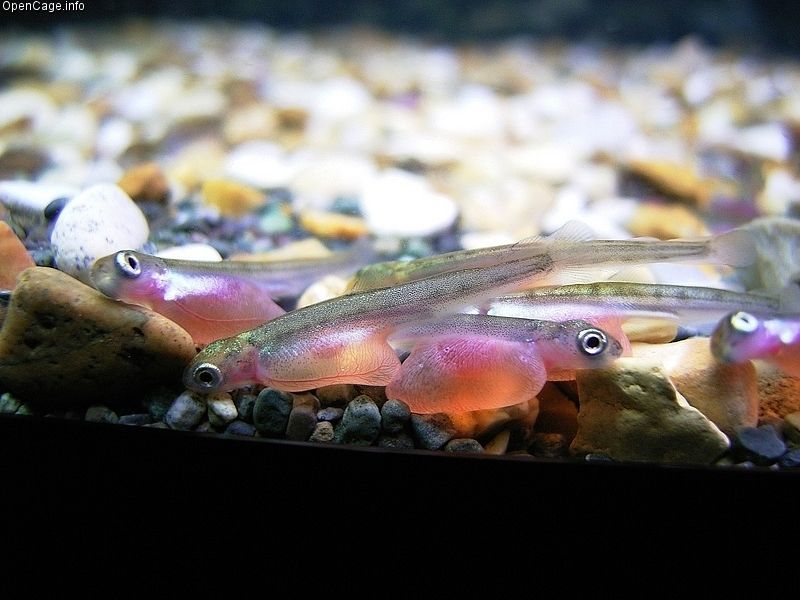 Kenny - Right. I think these are two of the key areas. If we're going to look at salmon particularly, some of these things don't apply to other species, but for salmon which is important to the UK, particularly in Scotland, these are very contentious issues.
Kenny - Right. I think these are two of the key areas. If we're going to look at salmon particularly, some of these things don't apply to other species, but for salmon which is important to the UK, particularly in Scotland, these are very contentious issues.
Taking sea lice first. There is evidence to show that sea lice from the farmed fish interact with wild fish and of course, vice versa, and that wild fish probably suffer as a consequence of that in terms of population. It's usually quite hard to disentangle specific cause and effect, for example, for declining salmon population because there's probably lots of interacting things, for example climate change is a big driver probably of salmon population numbers. For sea trouts which are more coastal species, probably the sea lice issue is more important one.
So a lot of effort is going on at the moment to try to reduce lice numbers on farms, and manage farms in such ways that they limit their interaction, but I think we're quite a long way from cracking that one myself.
Ben - If you have a concentration of fish, does that also affect the sort of the local food web and that normally, there wouldn't be so many fish here, they wouldn't be adding as many nutrients back into the water, they wouldn't be eating as much of the food that's there? Can it have that sort of environmental impact as well?
Kenny - Well they don't eat any natural food that's there, or very little natural food. They almost entirely eat what they've been fed. So, the output therefore are dissolved nutrients excreted and wasted feeds in particulate matter, faecal matter. So you'll have a potential for an impact in terms of increasing the amount of nutrient in the sea water which might be thought to lead to increased primary production and you will see profound effects on the seabed.
Just going back to the nutrients though, in terms of overall budgets if you're looking at nutrient run off from agriculture, that massively outweighs nutrient contribution from aquaculture. So, although there's a potential for some effect, at the moment, the levels of farming don't really realistically make that very likely. And also, for enclosed systems, there are government guidelines which have been calculated to try to reduce the possibility that fish farming will contribute to any change in the phytoplankton community, for example.
On the seabed, though, the story is different. We know a large amount now about the effects that fish farming has on the seabed, the changes to the benthic communities there and the profound biogeochemical changes that you get from essentially dumping a huge amount of organic matter onto a very small patch of seabed. Just to finish that point though - and I could talk all day about the profound changes because that's one of the things I'm interested in - it is a limited amount of seabed. It's generally restricted to a very small area around the farms, and it doesn't spread a huge distance.
Helen - We've touched on the fact that we have to give these fish something to eat and one of the big reasons we think that farmed fish is good is because it means you don't have to catch them from the wild. But isn't it true that actually, we are all going out and catching fish to feed to the farmed fish, and therefore, the problem is still there.
Kenny - Well, absolutely right. In the past, I think that everybody, particularly the feed companies and the farmers have recognised this now and there's a tremendous drive underway to substitute both fish meal protein and fish oil in salmon diets. Salmon are eaten, one of the great advertisings for healthy eating with salmon is their omega-3 fatty acids which have a huge range of human health benefits. They are delivered to the fish in terms of their fish oil. We are now substituting a large amount of fish oil. It varies by country and also by company, but we're substituting a lot of that from plant derived materials, and then using the fish oil, the more expensive and more healthy if you like, fish oil, to top up the fish at the end of their growing cycle, so that their fatty acid profile still gives us the health benefits. Similarly for protein, protein is pretty much protein and substituting protein from terrestrial plant meals is a big deal at the moment, and I think we can look forward to a time where a very small proportion of the diet is actually fisheries derived. Particularly if you end up with - fish oil is the big deal - but I suspect in the future, we will crack (and there's quite a lot of signs of it) a GM plant which will produce essentially fish oil with many of the same benefits, which you could either eat directly or you could feed to fish. Obviously, the GM issue is quite a sensitive one in Europe, but I think - my own belief in this particular one is that that will be one that we will see perhaps in a decade or two. But there's huge resistance from both consumer and producer at the moment to anything that has the word GM on it.
Ben - I believe the omega-3 fatty acids themselves actually come from algae. So rather than they're being something that the fish itself produces, if we could actually find a way of farming the algae, then we would be able to have this apparently very healthy oil without actually needing the fish at all.
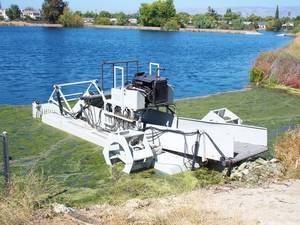 Kenny - Absolutely and there's a lot of work going on in growing algae generally. At the moment, macroalgae are the other biggest single class of organisms that are cultured, China produces, I think it's something like 14 million tons per year of cultured macroalgae. They have farms that you can see from space. However, these algae are not particularly rich in fatty acid. You get the fatty acids from microalgae. They're now being grown in large amounts, huge amounts of money are being poured into culturing microalgae, particularly as sources of biofuel.
Kenny - Absolutely and there's a lot of work going on in growing algae generally. At the moment, macroalgae are the other biggest single class of organisms that are cultured, China produces, I think it's something like 14 million tons per year of cultured macroalgae. They have farms that you can see from space. However, these algae are not particularly rich in fatty acid. You get the fatty acids from microalgae. They're now being grown in large amounts, huge amounts of money are being poured into culturing microalgae, particularly as sources of biofuel.
You will see that the biodiesel that we put in our cars I think 8% comes from a plant source, usually terrestrial oil seed derived, but there's a huge potential for using microalgae. Now these microalgae can also be harvested for their oil or other purposes, and you're right to say that you could then use them as components of animal feeds.
Ben - So actually doing this would also help reduce our reliance on the rainforest and so on, that are being cut down for things like palm oil, and other oil producing plants that may feed in to biofuel.
Kenny - Absolutely. The key thing with aquaculture is, it will never really mature and become a really big contributor until it separates itself from the terrestrial system entirely. The terrestrial food production system has big problems over the next 30, 40 years, in terms of feeding the world's growing population. These problems are to do with land area, to do with nutrients and fertiliser, very highly energy intensive, and of course, to do with freshwater supply. So if you can make aquaculture essentially close its production cycle and grow its food in the sea, then you obviate a large amount of these problems.
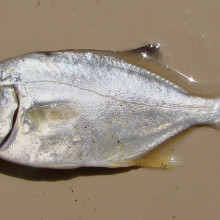
34:02 - Reusing Fish Poo
Reusing Fish Poo
with Dr Kevan Main, Mote Marine Laboratory, Florida
Helen - Well, as we've heard, aquaculture isn't restricted to the oceans. Many aquatic organisms can actually be farmed on land. This is potentially good news for reducing the environmental impacts of aquaculture because all the by-products can be contained, including large amounts of solid waste and enriched salty water. But how do you dispose of a whole lot of fish poo without harming the environment? Dr. Kevan Main heads up the Centre for Aquatic Research and Development at the Mote Marine Laboratory in Florida where they've come up with a novel new way to re-use this waste as fertiliser for farmed marine plants...
Kevan - You can't just grow anything in solid waste out of a saltwater system. If you put it on regular plants for vegetables or something like that, everything is going to die. And so, I entered into a partnership with a company that does restoration of wetland plants and their business is to grow a whole suite of species that are used to restore coastal environments in the south-eastern US. And so, they'll go in and replant areas that have been impacted, say by development or storms or hurricanes, or oil spills, or things like that. 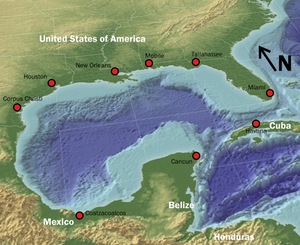 And so, they'd grow all these plants in freshwater and fertilise them, and grow them there, and then when they get their contracts to go and plant them back in a coastal environment, they'll expose them to salty conditions for a period of time. So they acclimate them back to the conditions so that when they put them out there, they're not completely shocked and they die.
And so, they'd grow all these plants in freshwater and fertilise them, and grow them there, and then when they get their contracts to go and plant them back in a coastal environment, they'll expose them to salty conditions for a period of time. So they acclimate them back to the conditions so that when they put them out there, they're not completely shocked and they die.
Helen - Kevan took me out to the greenhouse where they season the plants prior to replanting.
Kevan - These plants are absorbing the nutrients that are produced by the fish and turning it into plant material, and these plants have the potential to be used for restoration projects throughout the Gulf of Mexico. It's three different species that are found commonly along our coastline in Florida and up to the rest of the Gulf and every single one of them will eventually go out to restoration projects around the state.
Helen - And you said that they are being fed basically with fish poop. Is that right?
Kevan - Yes, that is right. What's happening is that we're getting a combination of both the solid waste or we call it fertiliser, and that's coming from the fish production unit and they're getting high nutrient water that is associated with that waste.
Helen - And that huge greenhouse contains more than 100,000 plants, but it only uses the waste from a relatively small number of fish.
Kevan - What amazes me about it is that I have less than 3,000 fish in the production unit there because we had some fish that were left over from an earlier research project that we were working on and we put them out there and we said, "Well, we'll just get started. Probably won't be enough nutrients for them but at least we have something going in there and hopefully the plants won't die." And so, we put them in there and we started sending the wastewater through there and sure enough, it was plenty. So, now I'm thinking that we might need - if we have this really stocked well, we might need three greenhouses instead of one because you're going to produce a lot of plant biomass.
Helen - Although it's clearly working well, this technique is still experimental. So to work out how best to deliver the fertiliser and enriched water, Kevan and the Mote researchers are doing a number of controlled trials.
Kevan - Because this is a research study, I have two raceways with plants in them and I'm using two different approaches to entering the solids into the plant systems. One of them, all the solid is actually removed prior to the water coming through and then only high nutrient water is coming through. This one, it has solids and water going right into that system. The great thing about that is this is a simpler system to build and operate, but the advantage to the other one is that you can pull the solids right off that system and then what we do is, when they're going to start a new crop of plants, they come and scrape off that solid material, take it back there and mix it with the potting soil. So it's essentially like adding fertiliser. And then the third treatment is a bag. It's called a geotube bag that just collect solids inside the bag.
Helen - And to find out more about where their fertiliser comes from, Kevan took me down to the ponds to meet the fish.
Kevan - Florida pompano which is a really exciting fish. People come here from all around the country, both to fish for it and to eat it in our local restaurants.
Helen - So it's tasty.
Kevan - Yes, it is. It's a really nice delicate white fish.
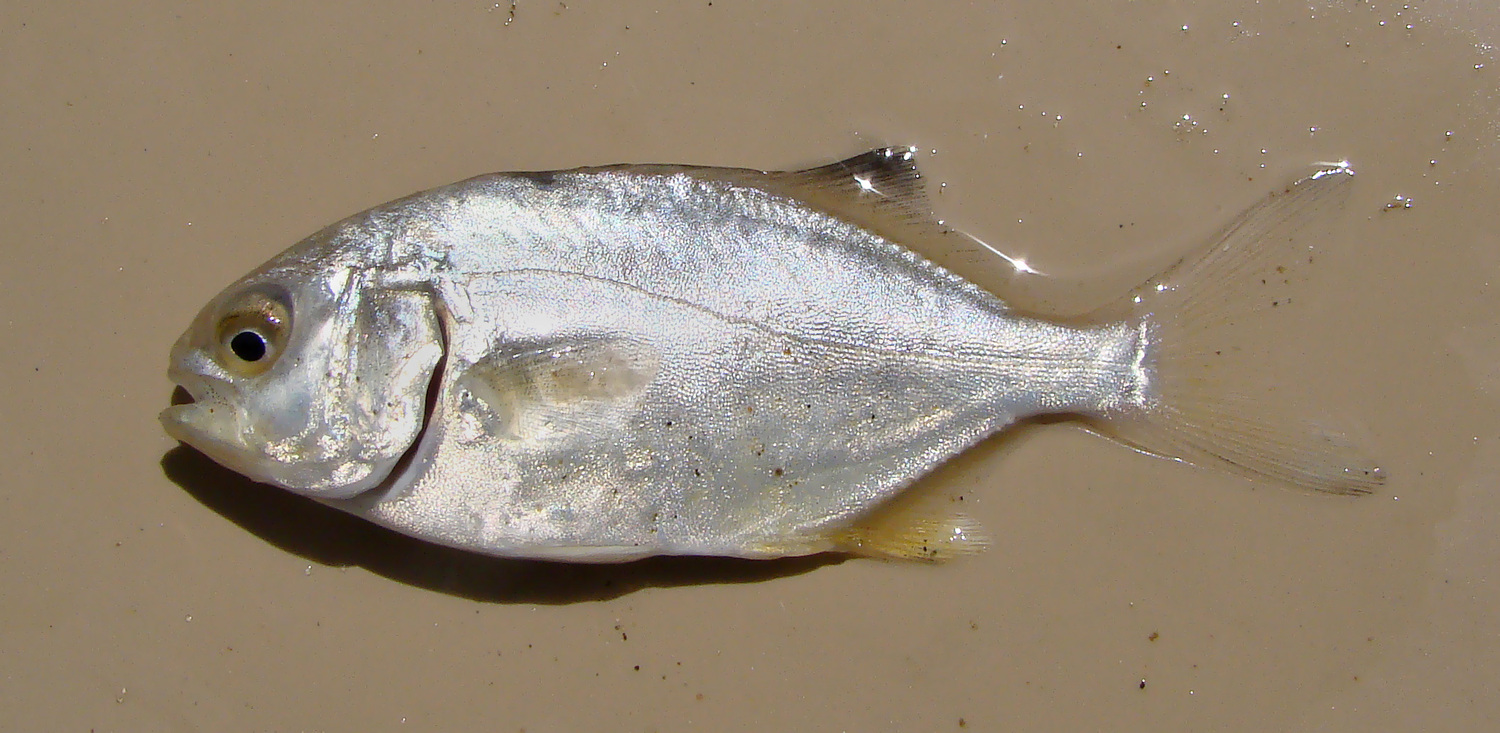 Helen - And the idea is that you're producing them here in this sustainable system and eventually, these will be sold.
Helen - And the idea is that you're producing them here in this sustainable system and eventually, these will be sold.
Kevan - That's exactly right. Both the plants and the fish will be sold at the end of the project and go in to the market.
Helen - And how long do we keep them here in this great big tanks in front of us? We've got these enormous round tanks. I'd say they're about 3 or 4 feet deep, is that right?
Kevan - They are actually 5 feet deep and the fish will stay in that system probably for about 9 to 12 months before they are market size.
Helen - So about a year old and then they're ready to eat.
Kevan - That's right.
Helen - So that's not too bad.
Kevan - No, it isn't. Especially when you compare it to some of the other big marine species, grouper or a fish like that when you're harvesting them out of the ocean, they could be 20 years old before you're harvesting them.
Helen - And you can release these guys back into the wild as well?
Kevan - Well you could. That is not a target for this particular project and the state of Florida is not currently targeting pompano for stock enhancement. It's not to say that you couldn't because the genetics of these are based on populations that are from this local coastline, so they certainly could be used for that.
Helen - Finally, if the waste keeps us in plants, where do the fish themselves come from? Persuading brood stock fish to spawn in captivity involves mimicking the natural environment and giving them a little hormonal helping hand.
Kevan - We first start with environmental cues. We use lighting, temperature, and moon cycle lights to condition them for the spawning conditions that we know that they normally react to in nature, and then right when they're just about ready to spawn, we will inject them with a hormone that causes their brain to say, "Okay, now's the time." Because we really haven't got all the cues right in place since, so in order to get everything just right, at least up to this point, we have to use a hormone implant. It works very effectively. We implant one day, 24 hours later, they'll spawn. Twenty four hours after that the eggs hatch.
Helen - That's ensuring the next generation of fish will continue to provide fertiliser for more plants. That was Dr. Kevan Main, head for the Centre for Aquatic Research and Development at Mote Marine Laboratory in Florida.
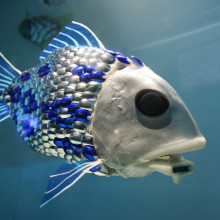
41:06 - Naked Engineering - Robotic Fish
Naked Engineering - Robotic Fish
with Professor Hueosheng Hu, University of Essex
Meera - For this week's Naked Engineering, Dave and I are looking into the field of biomimicry. This is a mimicking of biological organisms for their structures or their movements and this week Dave, we're looking into fish.
Dave - Yes. For nearly 200 years, engineers have been optimising one way of moving through water, essentially using a propeller. So we have a spinning propeller which pushes water backwards and you get pushed forwards. Now, nature uses an entirely different system and has spent tens of millions of years optimising this, which instead of using a rotating propeller, you use a flapping tail, and this has got a load of different advantages and disadvantages.
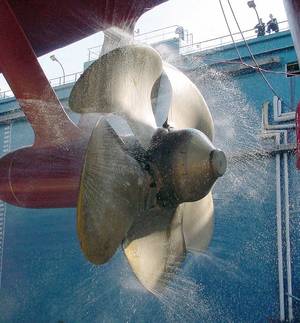 Meera - Well one scientist looking into this and designing robotic fish is Professor Huosheng Hu at the University of Essex. Now Huosheng, how do fish actually move through water?
Meera - Well one scientist looking into this and designing robotic fish is Professor Huosheng Hu at the University of Essex. Now Huosheng, how do fish actually move through water?
Huosheng - One kind of fish movement is generated by the tail and half of the body. They try to bend the body and tail in an S shape to generate a force and move forward.
Dave - So this is moving side to side and as the tail moves to the left, it's sort of bent to the right so the water kind of falls off the edge and gets pushed backwards, and then as it comes the other way, it generates lift in the other direction. Overall, it gets pushed forwards.
Huosheng - We call this body-tail motion.
Meera - So you first got into this area to make robotic versions of exotic fish. So, how did you even set about an initial design for this?
Huosheng - It's a big challenge to make a robot like a real fish. We cannot have similar muscle like a fish has and so, what we have in hand is only motors.
Meera - So we have one of your earlier designs here in front of us. It's a fish about half a metre in length. It's very aesthetic so it's the shape of a fish, you've got fins on, you've got a nice beautiful tail, blue and silver scales attached onto it as well.
Huosheng - We actually have a rigid head which inside, we put the computers, we put the sensors inside, also, we put the battery inside. And then we have a flexible link, three or four joints with three or four motors, concavely linked together just from the body and the tail section. So this can be driven by the electric power to bend the body like a real fish.
Meera - But I guess it's more than just simply getting this fish to move through the water. It needs to kind of know and direct itself through the water. So just coming out of the mouth here, I can see sensors sticking out and there must be other sensors within all to help it actually know perhaps when an obstacle is coming up or if it's about to bump into something.
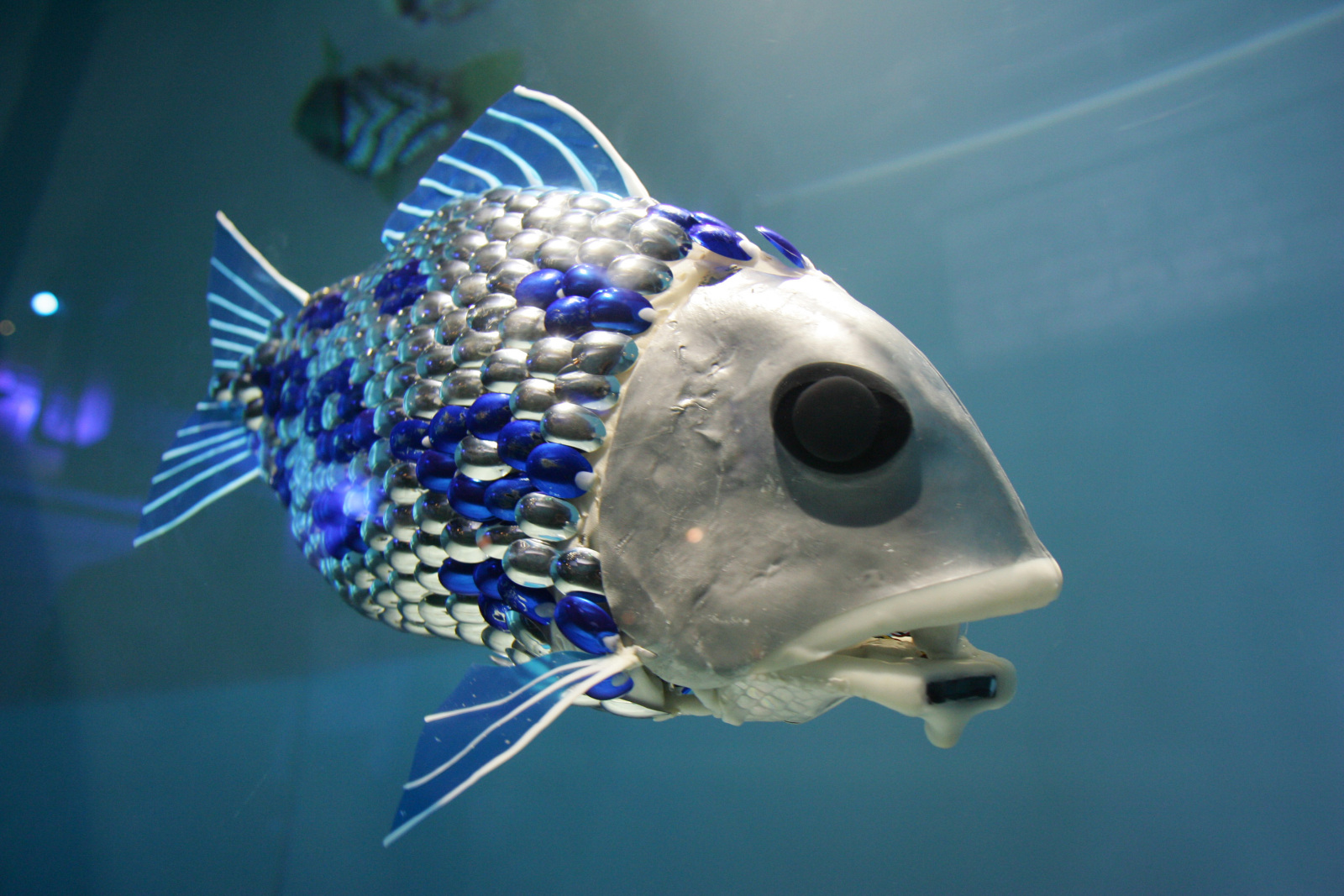 Huosheng - We have four infrared sensors to try to detect obstacle on the way. So, these are navigating sensors. On the other hand, we had a gyroscope inside, we have a pressure sensor inside. This try to control the motion of the fish.
Huosheng - We have four infrared sensors to try to detect obstacle on the way. So, these are navigating sensors. On the other hand, we had a gyroscope inside, we have a pressure sensor inside. This try to control the motion of the fish.
Meera - So initially, you've created this very aesthetic fish here, but there are uses for this in environmental monitoring and the monitoring of water pollution which is what your next generation of fish have been designed for.
Huosheng - What we've tried to do is use a team of robotic fish in the sea port to detect pollution.
Meera - So we're moving out of aquarium tanks, water tanks, out into the sea now. There must be many more challenges and many other factors to consider.
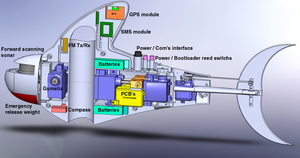 Huosheng - Once the fish move into the sea, we have to put enough power for the fish to swim against waves, currents, and also, we have to put a lot of sensors inside to actually find a way to go.
Huosheng - Once the fish move into the sea, we have to put enough power for the fish to swim against waves, currents, and also, we have to put a lot of sensors inside to actually find a way to go.
Dave - And I guess navigation is going to be really important and the traditional way of navigating these days using GPS. As soon as you're underwater, it's going to block the microwave signals which carry the GPS. How do you navigate in this kind of environment?
Huosheng - We actually use same principle like a satellite, but instead we used a sonar beacon embedded into the sea ports. Sonar beacons propagate sonar signals. We know each of the beacon's position and each robotic fish has a sonar receiver doing the triangulation.
Dave - So basically, you're putting a load of transmitters your fish can listen to several different transmitters, and work out the time difference between them, and so, from that, it can work out exactly where it is in three dimensional space, but only inside the port.
Huosheng - Yes, exactly. We call this a structured environment.
Meera - You've actually changed a lot of the original structure as well, so the material for example, it's just purely made of carbon fibre. It has this shape and structure of a fish, but there are no aesthetic there. it's purely about handling sea and moving through it.
Huosheng - The fish has to be agile but robust, so we try to make the body rigid.
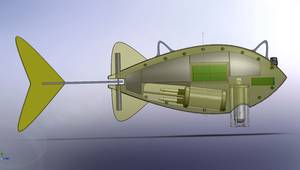 Dave - And also looking at the tail, instead of the previous version which had four joints, this seem to be much, much simpler.
Dave - And also looking at the tail, instead of the previous version which had four joints, this seem to be much, much simpler.
Huosheng - We actually first stage - we tried to simplify the driving mechanism from the four joints, reduced to the two joints. Once this is successful, we're looking for more joints to gain more flexibility. This is an engineering compromise.
Meera - What actually are the benefits of using this fish-like structure in order to monitor pollution? What makes them better than propellers?
Huosheng - There are two benefits. Firstly, fish-like movements create no disturbance to the water environment. Secondly, robotic fish can peacefully swim in the port, without causing any danger to the real fish.
Dave - If the fish isn't actually producing an awful lot of turbulence behind it, does that mean that in theory it could be more efficient than a conventional propeller?
Huosheng - In theory, yes because submarines and ships generate a lot of turbulence to the environment and the waves. The efficiency is not very high actually, but real fish, they are very, very efficient swimmers. We are trying to establish how much energy is saved by body movements compared with the thrust or rotational movements. That's our next goal.
Ben - Professor Huosheng Hu from the Computer Science Department at the University of Essex showing Meera and Dave his new generation of robotic fish. You can see the fish in action here.
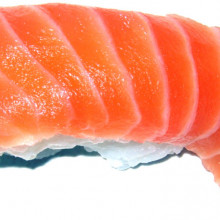
Are farmed fish any less tasty or nutritious than wild caught?
Kenny Black, from the Scottish Association for Marine Science, answered this question...
Well, if we talk about salmon, I think taste is probably too subjective a thing for me to talk about.
Nutrition, I think, probably in terms of crude nutrients, there's probably not much difference. Maybe farmed ones are a bit fattier perhaps, but then maybe the fat is good for you. I think the interesting thing for human health though is the whole story about contaminants. We heard earlier about the contaminated sediments.
Unfortunately, the marine environment is contaminated with all of these plus things like mercury, and they just walk the way up the food chain.
So, these have got in to all the fishery products that we eat and also, they get into things like fish oil. The good thing about fish farming is that you can clean them out. You can actually take the oil and strip out these chemicals so you could argue that a farm fish has a potential to have much lower contaminant burden than a wild fish...
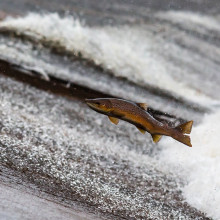
Are farmed fish more disease-prone?
Kenny Black, from the Scottish Association for Marine Science, answered this question...
They are disease prone.
Salmon are pretty robust fish and most of the other cultured fish that we have are cultured because they're not too susceptible to diseases.
Nonetheless, diseases occur anywhere you culture a very large number of organisms in close proximity, you increase the chances that a disease will become an epidemic within that population. So it's all about population size ultimately.
So, the bigger the number of fish, the more risk there is of a disease...
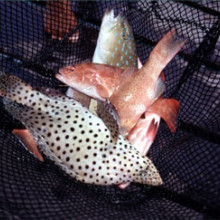
Is there a sustainable way to feed farmed fish?
Kenny Black, from the Scottish Association for Marine Science, answered this question...
It's something that's happening already.
You'll find that particularly, not in the UK as much as in other countries, but some other countries are really using very little fish meal - protein from fish - in their fish feeds.
Still using a bit of fish oil, particularly for finishing off fish as I mentioned earlier on, but we are looking at the future for diets which contain very, very little fish product and one of the reasons for that will also be pushed by the fact that more and more people are looking at - instead of grinding up little fish and turning them into fish meal or pig meal and all the rest, because there's lots of other things each fish meal, will feed it to lots of different animals.
But, instead of doing that, we actually eat this fish directly and cut the corner if you like. That's a much more efficient thing to do...

Would modified escaped salmon breed with wild stock?
Kenny - Well, if we do have them grown in open cages, and these fish have been developed - not in Europe but they have been developed. They do exist. If they did escape, unless we did something about it, in which I will talk about in a minute, there'll be no real reason to suppose that they'd be any more benign than any other escaped fish. Escaped fish generally are bad news because they interbreed with wild populations to their detriment. If you've got a particular gene in there, it may have all sorts of consequences, people have talked about ecological and genetic consequences. One of the things you could do if you really wanted to do this which I don't think is a good idea anyway. There's no need to do it, but if you really wanted to do it, you could put in a suicide gene. You could put in a gene whereby, the animal has some dietary obligatory requirement so that when it went into the wild, it wouldn't have that and it would die.
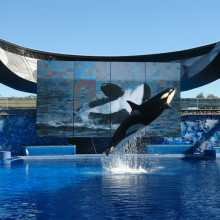
51:55 - Does the music at Sea World bother the whales?
Does the music at Sea World bother the whales?
We put this question to Mariana Melcon from the Scripps Institution of Oceanography at the University of California in San Diego... Mariana - As far as I know it hasn't been studied whether whales are bothered by loud music in Sea World. It's true actually that the sound propagates better in the water than in the air. However, when the airborne sounds reach the water, lots of energy is lost. This means that the loud music would not be as loud in the water as it is in the air. Since whales spend much more time underwater than performing aerial displays, I wouldn't expect them to be as bothered as humans could be. I guess though that people hitting the glass walls and shouting could be somewhat disturbing.
Now their own sounds could also be affecting them because toothed whales produce high intensity sounds. They are reflected from objects and return as echoes. So, the animals analyse these echoes to, for instance, find their prey. Now imagine how loud it can be for them, emitting these sounds which can be approximately as loud as ships, reflecting in the surrounding walls. So summarising, animals may be annoyed by the loud music, but in terms of acoustics, I think that there are other factors that could be affecting them more.
- Previous Computer Designed Proteins May Fight 'Flu
- Next Marine Machines










Comments
Add a comment